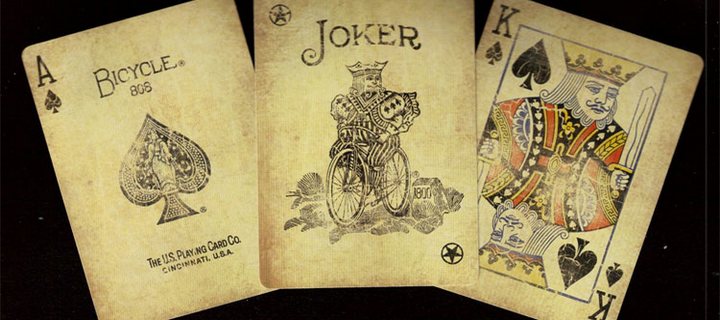History and Use of Playing Cards

Playing cards are an integral attribute of gambling in a real casino and in an online casino.
Decks of playing cards are simultaneously simple and complex. They are small, easy to carry, and colorful. They connect with the fact that people love secrets. When playing a game, only you know your hand, so you hold a secret. The thought that you will beat your opponents appeals to desires of control.
Playing card deck have an incredibly rich and mysterious history. The many facts are known about the origins of card deck but several of the details surrounding the creation of cards are still subject to debate. Often the problem is that paper is a fragile medium, so it is almost impossible to truly trace the originals, since samples no longer exist.
Early examples of cards can be traced to India, Persia, and Egypt but most experts agree that playing cards originated in China, alongside games such as Dominos and Mahjong. The Chinese invented paper and printing, and there are examples that can be traced to China dating all the way back to 1294! There are even similarities that exist between today’s cards and decks that were made 800 years ago!
Other historians believe that cards originated in Persia, where they then spread east to India and China. They also spread west to Egypt, and finally into Europe.
It is believed that cards arrived in Europe primarily from trade with Egypt. There are many striking similarities between the 14th century cards and cards of today. The old deck had 4 suits. Swords evolved into the Clubs of today’s decks. Sticks evolved into Clubs. Suits of Cups and Coins can still be found on decks made in Italy and Spain today. Many different areas were eager to put their own styles and cultures into their decks, as evidenced by suits of Acorns, Hawk Bells, Hearts, and Leaves found on German decks. These symbols are influenced by the German pride and love of their natural surroundings.
After playing cards first arrived in Southern Europe, they spread quickly to other parts of Europe. Some even refer to the speed at which cards traveled throughout Europe as the ‘Invasion of Playing Cards’. Due to the small size and convenient portability of a pack, it was very easy for soliders to carry cards across Europe and introduce them to new regions. It is very likely that cards first arrived in England in the pockets of French soldiers. Cards were finally introduced to America by explorers and soldiers.
While different cultures infused their own cultures into their decks, they all used symbols that were attractive and easy to identify. They were also based on real objects.
Early decks had no Queens, which reflected the fact that courts were male-dominated. Early decks had a King and 2 ‘Marshalls’, but no Queen. Even today Italian, Spanish, and German cards have a variation of the 3 male court cards. The exception is the French design, which does have a Queen.
The common red and black suit color scheme that we know today was invented in France. This simple creation offered better readability and became the basis for the modern Anglo-American deck. The core elements of the deck and major suit systems were established by the end of the 15th century, and very little has changed since.
Initially, playing cards were made by hand. This made them expensive and accessible only to the upper class.
Use of playing cards in people's lives
Playing cards were also used for much more than playing games. For a long time, only the faces of cards were printed, leaving the backs blank. These blank backs were one of the most convenient sources of paper, so they were often written on and used as coupons, love letters, invitations, and even currency.
In 18th century Netherlands, mothers would leave a message on the back of a card to identify an abandoned child. If card was torn in half, it meant that the mother would someday return with her half of the card to claim the child. If card was whole, it mesnt that the child was fully abandoned and the mother would not return.
Some people believe that the images in cards are the work of secret societies. Since the true origins are still unknown, many think that all of the suits, values, and symbols could have hidden meanings.
Some of the popular theories include a correlation to the natural world. There are 4 suits, which relate to the 4 seasons. There are 52 cards - one for each week of the year. The 13 cards per suit relate to the 13 cycles of the moon.
Many theorists believe that the Freemasons concealed messages in the cards. For example, the Jack of Hearts seems to hold a sprig of Acacia, which was used in Masonic rituals. However, this is not an exclusive Masonic emblem. The Queens hold roses, which could also show a connection to the Freemasons.
To date, no hard evidence has been discovered of messages placed by intention, as the results would be far more blatant. Thus, it is very difficult to prove or disprove any given theory. The mere existence of these stories proves the importance of symbolism and meaning within the deck.

